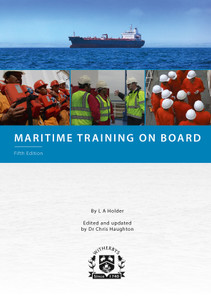
This manual is designed to encourage safe working practices and a healthy living environment on board ship. It contains safety checklists and practical examples of safe operations, supported by relevant imagery. Job description tables ensure crew are fully trained and informed on crew accountability on board, as well as risk mitigating factors.
The safety and health of seafarers is protected by an impressive framework of conventions and legislation. The purpose of this manual is to highlight the basic principles that the framework contains and to help seafarers put them into practice. The manual describes how to implement the procedures, such as risk assessment and safety inspections, that can prevent accidents. Guidance on how to maintain high levels of health and hygiene on board is also provided. There is discussion of the human factor in accident prevention and how understanding it can be used to create a strong and resilient safety culture on board.
Safety and Health at Sea is a manual designed to help ships’ Masters, safety supervisors and officers to create a safe and healthy working and living environment for ships’ crews.
There is a large list of conventions, laws and regulations, both national and international, governing safety and health at sea, but the manual is not exclusively about the law. It is about how to put the principles on which the legal framework is based into practice.
The manual is for reference, but its contents should be used selectively for advice and guidance on particular aspects of safety and health.
Everyone involved in shipping benefits from making the industry safer. Accidents cost money and can result in claims from customers, so shipping companies benefit from their reduction. Improvements to safety benefit customers by reducing the damage and delay that accidents create. Seafarers benefit from being able to earn their livings free of the danger of being injured or killed.
Accidents don’t just happen, they are caused. Seafarers who can see that safety is not a major priority for their company are unlikely to make it their own.
Accidents on board are much more likely if policies are unclear, responsibilities are undefined, procedures and controls are absent, or they only exist on paper and training is inadequate or inappropriate.
Accidents happen when people believe that the rules don’t apply to them, that safety is someone else’s problem, that their jobs will be easier and quicker if they ignore safe practices or even that working safely is ‘soft’.
Companies’ safety cultures must be strengthened, effective safety management systems must be put in place and individuals must be shown how to change their attitudes and behaviour.
Most ships have rules and regulations governing safety, often written in language that is hard for anyone but lawyers to understand. It is the lack of implementation, not documentation, that is the problem. Seafarers are practical, action oriented people. They will respond to a clear plan of action, particularly one which they can see is being pursued with determination.
Rules, procedures and controls, although important, will not improve safety on their own. Major improvements will only happen when each individual puts safety first, both for themselves and for their fellow seafarers.
While this is the case in every industry, it is especially important in shipping. Ships, particularly ocean going ships, are not like workplaces ashore. They are closed communities of people who live and work together 24 hours a day. Individuals are not subject to the same external influences as those who work ashore. And all the motivation to improve safety has to be generated from within the community of seafarers on each ship.
1 Shipboard Safety System
1.1 Responsibilities
1.2 Structure
1.3 Procedures
2 Tools for Improving Safety
2.1 Accidents: Causes and Prevention
2.2 A Safety Supervisor’s Job Description
2.3 Checklists
2.4 Accident Prevention
3 Health on Board
3.1 A Fit and Healthy Crew?
3.2 Be Prepared
3.3 General Health Protection on Board
3.4 Hygiene
3.5 Substances Hazardous to Health
3.6 Infectious Diseases and Malaria
4 Safety and Health Training
4.1 Principles
4.2 How to Plan, Run, Assess and Follow Up a Training Session
4.3 Basic Safety Training on Board
5 Reviewing Safety and Health on Board
5.1 Organisation of Safety and Health on Board
5.2 A Summary of Responses to the Safety and Health Questionnaire
6 The Human Factor
6.1 Safety Culture
6.2 Understanding Accidents
6.3 Human Behaviour
7. Practical Examples
7.1 Mooring line pays out too fast
7.2 Stairs slip-up injures crewman
7.3 Scaffolding comes crashing down
Appendices The Most Relevant IMO and EU Regulations
1. The IMO MLC Maritime Labour Convention
2. The ISM Code
3. The STCW Convention and its Relationship to the ISM Code
Arne Sagen
Arne Sagen, MNIF, ALCM, CNI, has a multidisciplinary experience in ship operation ranging from shipping companies Superintendent to DNV Principal Surveyor. Other roles Arne has held include ISM Code Lead Auditor, appointed flag State Inspector for Namibia and Port State Inspector for Egypt, Trinidad and Tobago. He has authored several publications on various aspects of ship operation.
- Number of Pages:
- 120
- ISBN:
- 9781856099011
- Binding Format:
- Paperback
- Book Height:
- 296 mm
- Book Width:
- 210 mm
- Weight:
- 0.8 kg
- Author:
Arne Sagen
- Published Date:
- May 2020
- Preview:
- Yes





